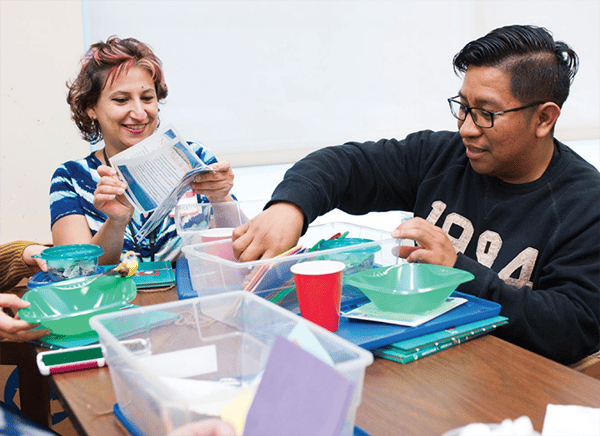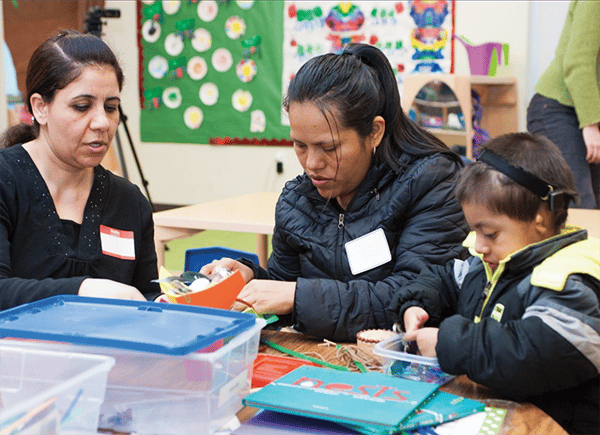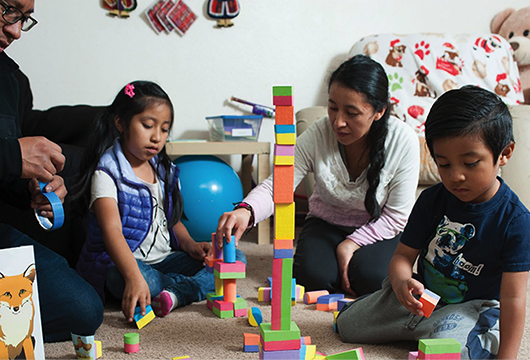TERC Blog
Head Start on Engineering
Supporting Engineering Interest Development in Early Childhood for Low-Income Families
In the United States, there are large and persistent disparities across communities in the available opportunities for children and their families to access quality STEM learning experiences and connect meaningfully with STEM throughout their lives—especially within the field of engineering.
 Parents get comfortable with the engineering design process at one of the HSE parent workshops.
Parents get comfortable with the engineering design process at one of the HSE parent workshops.
Engineering thinking and problem-solving skills are now integral topics in STEM education and essential to success in work and life (Moore et al., 2014). Engaging preschool-age children and their families in this topic is a critical opportunity. Children begin building the foundations of engineering-related knowledge, skills, and interests before they enter school, thus supporting not only STEM engagement but also a variety of fundamental learning and development domains, such as problem-solving and mastery motivation (McClure et al., 2017). Unfortunately, children from underserved and under-resourced communities, especially Spanish- and English-speaking families from low-income backgrounds, remain underrepresented in engineering (National Science Board, 2018). These populations face a variety of barriers in pursuing engineering degrees and careers, including a lack of culturally and linguistically relevant learning resources and out-of-school enrichment opportunities (Takeuchi et al., 2019).

Since 2015, the Head Start on Engineering (HSE) initiative (https://hse.terc.edu) has worked to address these challenges by engaging staff and families in the Mt. Hood Community College (MHCC) Head Start program, based in Portland, Oregon. Conducted in partnership with MHCC Head Start, University of Notre Dame, and the Oregon Museum of Science and Industry (OMSI), HSE is a multi-component, bilingual (Spanish and English) program designed to engage low-income children ages 3 to 5 and their families in the engineering process. The overarching goal of HSE is to help families develop long-term interests in engineering and science so they will have the skills, knowledge, and confidence they need to be successful. Beyond school readiness, the program is about helping children and their families develop a passion for engineering and science that motivates them to engage with these topics throughout their lives—building what are often called long-term interest pathways. Unlike many other preschool engineering or science programs, HSE focuses on the family and home-based learning experiences first and then creates complementary classroom activities to support this learning.
 A family reads a storybook associated with the HSE nestbuilding engineering design challenge.
A family reads a storybook associated with the HSE nestbuilding engineering design challenge.
Program Model
What does an early childhood engineering program look like when it supports engineering-related interest development for the whole family and integrates multiple experiences across contexts for parents and children? The backbone of HSE is a set of four bilingual family take-home engineering kits. Each kit centers on a hands-on engineering design challenge and includes the following:
- a bilingual storybook carefully selected to launch the activity and create a context for the engineering process;
- simple materials parents can easily reuse, replace, and supplement;
- a parent facilitation guide with instructions, facilitation tips, and extension ideas; and
- online videos demonstrating the take-home activities.
For example, the Fox and the Hen activity kit challenges parents and children to work together to build a tower of foam blocks that is over one foot high (https://vimeo.com/256122624). To set the context, the family reads a story about a group of hens looking for ways to protect their nests from a fox. After reading the storybook, families build a tower to protect the nest and then test their design by measuring it against a one-foot high cardboard image of a fox included in the kit.
These take-home kits are the anchors for the array of HSE program components integrated within the Head Start model, which also includes:
- a three-part parent workshop series;
- classroom activities designed to mirror the take-home kits;
- home visits by Head Start staff to check in with families; and
- a culminating science center field trip.
Across these experiences, the HSE program emphasizes the engineering design process, rather than engineering careers, as a topic and skill closely connected to family life and early childhood play. The parent workshops describe engineering as “designing and testing ideas to solve problems in work and life,” and the engineering design process is introduced as an iterative cycle: ask, imagine, plan, create, improve (Cunningham, 2018). The word “engineering” is used throughout, but the focus is sparking and sustaining family interest in the engineering design process.
 Children and parents build a tower to protect a chicken from a fox with one of the HSE take-home activity kits.
Children and parents build a tower to protect a chicken from a fox with one of the HSE take-home activity kits.
Underlying this program model is the fundamental belief that interest development and engagement with engineering (and other STEM topics) at this age involves not just the child but the whole family (Pattison, et al., 2016). In other words, parents and other significant adults change and learn in parallel with children and learning and development are supported by adults as children gradually develop more skills, knowledge, and autonomy. For example, a child may continue to be excited about using the HSE take-home kits, while at the same time the parent (through the workshops and engaging with the kits) begins to broaden their understanding of engineering and starts making connections between the engineering design process and everyday life. Both parent and child are motivated to seek out new engineering-related experiences, facilitated by the parent’s growing awareness of different opportunities such as the local science museum or engineering-related books at the library, and the whole family begins to see engineering and problem-solving as something they enjoy doing together.
What We Are Learning
The ongoing development and testing of the HSE program has created a unique context for studying what engineering can look like with young children and their families, how parents and children develop ongoing interests in this topic, and the types of activities and educational support systems that effectively spark and sustain these interests. Since 2015, we have conducted a series of studies to pilot and improve the program, develop a theoretical model of the family interest system, and explore the patterns and processes of long-term, engineering-related interest development (Pattison et al., 2018).
The research has highlighted three components of interest development that appear to vary across families and over time: parent awareness, knowledge, and values; family engagement with engineering activities; and family use of the engineering design process. Within each of these categories, we have observed important shifts in a subset of families that potentially signal movement to deeper and sustained levels of engineering interest:
- family members seeing engineering everywhere;
- families going beyond HSE to engage with other engineering-related activities and experiences; and
- parents and children taking on new roles as teachers or facilitators of engineering (Pattison et al., 2018).
Gracias al conocimiento de la ingeniería hemos estado aprendiendo mucho y saber que todos somos ingenieros desde los más chiquitos de las casa hasta los más grandes.
[Thanks to the knowledge shared about engineering, we have been learning a lot—including how we are all engineers, from the youngest in the house to the oldest.]
—Parent who has participated in the HSE program
In addition, pre- and post-program assessments have shown significant increases in parents’ personal interest in engineering, comfort supporting their children’s engineering-related interests, and broad understanding of engineering as related to problem-solving in everyday life. Families frequently used the HSE activities and engaged in other engineering-related activities, such as talking about engineering, finding examples of engineering in everyday life, and using engineering skills during play. Similarly, Head Start staff members increased their personal interest in engineering, confidence engaging children and families with engineering activities, and frequency incorporating engineering into the classroom or family programs (Pattison et al., 2018).
I really enjoyed being with this program. The program had great ideas for children this age. I like how we read a book and add an activity to it—that helps to retell and talk about the book.
—Head Start teacher
 A Head Start teacher incorporates the HSE activities into their classroom.
A Head Start teacher incorporates the HSE activities into their classroom.
Most recently, the team has completed a series of retrospective interviews with 18 Spanish- and Englishspeaking families one to two years after their participation in HSE (Pattison et al., 2019), when children are in kindergarten or first grade. Analysis of the interviews highlights how the program has catalyzed and supported ongoing engineeringrelated interests for both parents and children. Families reported broadened perspectives on engineering, ongoing use of the HSE activities and materials over several years, seeking out new engineering-related resources and experiences, and using the engineering design process as inspiration for finding engineering in everyday life. The study also suggests the different factors that influence how families develop interests through programs like HSE, such as family values that may or may not align with program goals, parent perceptions of their roles supporting their children’s interests, and life challenges that may disrupt ongoing interests—especially for low-income families with limited resources.
Looking Ahead
The research findings are shedding new light on how STEM interests develop in early childhood and the ways that researchers and educators can make STEM learning experiences more relevant and impactful for Spanish- and English-speaking families from low-income communities. Moving forward, we aspire to a long-term vision of the HSE initiative as a thriving research-practice partnership with the MHCC Head Start community that generates ongoing research findings, inspires other partnerships across the country, and provides tools and resources to empower families to make engineering part of their lives.
 Families visit the Oregon Museum of Science and Industry to celebrate the end of the HSE program.
Families visit the Oregon Museum of Science and Industry to celebrate the end of the HSE program.
In support of this vision, the HSE initiative will launch two new projects. The first will extend the reach of the HSE program in partnership with Metropolitan Family Service (MFS), a community organization that serves low-income, racially and ethnically diverse communities across the Portland, Oregon metro region. With funding from the National Science Foundation (NSF 1930848), TERC, and University of Notre Dame, MFS will adapt the HSE program and activities for MFS’s parent and family engagement model. The team will then conduct a three-year design-based research study to better understand how the characteristics of hands-on family engineering activities influence how preschool-age children and their parents engage in the engineering design process.
For the second project, also supported by the National Science Foundation (NSF 1906409), we will extend the existing program within the MHCC Head Start program and continue to investigate the ways families develop interests related to engineering and STEM across contexts and over time. The team will use a design-based implementation research approach (Fishman et al., 2013) and integrated longitudinal case studies to refine the HSE program with a larger group of families to serve as an innovative model for other communities around the country. The expanded program will also advance knowledge about family-level engineering interest development systems and how they can be supported by ongoing, cross-context learning experiences, especially as children transition from preschool into kindergarten.
From our perspective, the HSE program will always be a work in progress. We welcome educators and researchers to adapt and expand the ideas from HSE, which are available on the project website (https://hse.terc.edu). In the future, we hope to collaborate with other communities across the country to explore how the HSE model might be adapted to their needs and goals, and how we can collectively create a learning ecosystem that effectively engages families from all communities in lifelong STEM learning.
Photo Credits: ©Emily Maletz 2017
Download Hands On! Fall 2019
Acknowledgements
The Head Start on Engineering initiative has been supported in part by the National Science Foundation (DRL-1515628, EEC- 1930848, DRL-1906409), Spencer Foundation, Oregon Community Foundation, Collins Foundation, Boeing Corporation, University of Notre Dame, and Juan Young Trust. Any opinions, findings, and conclusions or recommendations expressed in this material are those of the authors and do not necessarily reflect the views of the funders.
Authors
Scott Pattison, Ph.D., is a Research Scientist at TERC. He partners with communities to study and support STEM education, learning, and interest development in free-choice and out-of-school environments, including museums, community-based programs, and everyday settings.
Smirla Ramos-Montañez, Ph.D., is a Research and Evaluation Associate at TERC and OMSI. She is interested in culturally responsive research, evaluation, and STEM learning in informal and formal settings.
Gina Svarovsky, Ph.D., is an Assistant Professor of Practice at the University of Notre Dame Center for STEM Education. For nearly two decades, she has been interested in how young people, and especially those from traditionally underrepresented populations, learn science and engineering in both formal and informal learning environments.
Cynthia Smith is an Associate Director at Mt. Hood Community College Head Start. She oversees and ensures quality services and care are provided to Head Start and Early Head Start children and families throughout East Multnomah County.
Verónika Núñez is the Learner Empowerment Manager for Research and Development at OMSI. She works with teams and communities inside and outside the museum to ensure the integrity of the program and exhibit co-development process, and the integration of best practices for education and inclusion.
Annie Douglass is the Early Childhood Engagement Manager at the OMSI. She designs programs and exhibits that build early STEAM identities, make visible the abilities of young children, and celebrate the unique and joyful power of playful informal learning.
References
Cunningham, C. M. (2018). Engineering in elementary STEM education: Curriculum design, instruction, learning, and assessment. New York, NY: Teachers College Press.
Fishman, B. J., Penuel, W. R., Allen, A.-R., Cheng, B. H., & Sabelli, N. (2013). Design-based implementation research: An emerging model for transforming the relationship of research and practice. National Society for the Study of Education, 112(2), 136–156.
McClure, E. R., Guernsey, L., Clements, D. H., Bales, S. N., Nichols, J., Kendall- Taylor, N., & Levine, M. H. (2017). STEM starts early: Grounding science, technology, engineering, and math education in early childhood. Retrieved from http://www.joanganzcooneycenter.org/publication/stem-starts-early/
Moore, T. J., Glancy, A. W., Tank, K. M., Kersten, J. A., Smith, K. A., & Stohlmann, M. S. (2014). A framework for quality K-12 engineering education: Research and development. Journal of Pre-College Engineering Education Research (J-PEER), 4(1).
National Science Board. (2018). Science and engineering indicators 2018 (No. NSB-2018-2). Retrieved from https://www.nsf.gov/statistics/2018/nsb20181/
National Science Foundation. (2019). Award 1930848. Retrieved from https://www.nsf.gov/awardsearch/showAward?AWD_ ID30848&HistoricalAwardsúlse
National Science Foundation. (2019). Award 1906409. Retrieved from https://www.nsf.gov/awardsearch/showAward?AWD_ ID06409&HistoricalAwardsúlse
Pattison, S. A., & Dierking, L. D. (2018). Early childhood science interest development: Variation in interest patterns and parent-child interactions among low-income families. Science Education, 103(2), 362–388.
Pattison, S. A., Núñez, V., Smith, C., Svarovsky, G. N., Benne, M., Corrie, P., & Stewart, R. (2018). Introduction to the Head Start on Engineering pilot program: Engaging families with preschool children in the engineering design process. Retrieved from https://HSE.TERC.edu
Pattison, S. A., & Ramos-Montañez, S. (2019). Long-term family interest development: Retrospectives interviews with parents one to two years after a family-based preschool engineering program. Manuscript in preparation.
Pattison, S. A., Svarovsky, G. N., Benne, M., Corrie, P., Núñez, V., & Smith, C. (2018). Head Start on Engineering: 2017–18 program year evaluation report. Retrieved from https://HSE.TERC.edu
Pattison, S. A., Svarovsky, G. N., Corrie, P., Benne, M., Nuñez, V., Dierking, L. D., & Verbeke, M. (2016). Conceptualizing early childhood STEM interest development as a distributed system: A preliminary framework. Presented at the National Association for Research in Science Teaching Annual Conference, Baltimore, MD. Retrieved from http://www.informalscience.org/conceptualizing-early-childhoodstem- interest-development-distributed-system-preliminary-framework
Pattison, S. A., Svarovsky, G. N., Gontan, I., Corrie, P., Benne, M., Weiss, S., … Ramos-Montañez, S. (2017). Teachers, informal STEM educators, and learning researchers collaborating to engage low-income families with engineering. Connected Science Learning, 4. Retrieved from http://csl.nsta.org/2017/10/headstart-engineering/
Pattison, S. A., Weiss, S., Ramos-Montañez, S., Gontan, I., Svarovsky, G., Corrie, P. G., … Smith, C. (2018). Engineering in early childhood: Describing family-level interest development systems. Presented at the NARST 91st Annual International Conference, Atlanta, GA. Retrieved from http://informalscience.org/engineeringearly-childhood-describing-family-level-interest-development-systems
Svarovsky, G. N., Pattison, S. A., Verbeke, M., Benne, M., & Corrie, P. (2017). Head Start on Engineering: Early findings (work in progress). Presented at the ASEE Annual Conference & Exposition, Columbus, OH. Retrieved from https://www.asee.org/public/conferences/78/papers/20296/view
Takeuchi, L., Vaala, S., & Ahn, J. (2019). Learning across boundaries: How parents and teachers are bridging children’s interests. Retrieved from http://joanganzcooneycenter.org/wp-content/uploads/2019/06/jgcc_ learningacrossboundaries.pdf







